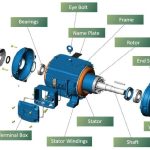Simple Guide to Testing Electric Motors

First Steps: Look and Check
Before you test any electric motor, you need to check it carefully with your eyes and hands. Think of it like giving your car a quick check before a long drive. Here’s what to do:
- Safety First
- Turn off all power to the motor
- Make sure no one can turn it on by accident
- Put on safety glasses and rubber gloves
- Keep a fire extinguisher nearby just in case
- Look at the Outside
- Check if the motor looks damaged
- Look for dirt and rust
- Make sure no wires are broken or worn out
- Check if all bolts are tight
- Simple Physical Checks
- Try turning the shaft by hand – it should move smoothly
- Look at the bearings – they should have enough oil
- Make sure the cooling fan isn’t blocked
- Check if all parts are tightly connected
- Write Everything Down
- Copy down the motor’s information plate
- Note any damage you see
- Write down any strange noises or smells
- Record the room temperature
- Note when the motor was last fixed
Testing the Motor’s Electrical Parts
- Testing the Insulation
This test (called a Megger test) checks if the motor’s insulation is good:
- Unplug all wires
- Connect special test equipment
- Take readings after 30 and 60 seconds
- The numbers should be above certain levels depending on your motor’s size
- Testing the Windings
- Measure the electrical resistance in each part
- All measurements should be very close to each other
- If they’re different, something might be wrong
- Special Tests
Some tests need special equipment and trained people:
- Surge testing checks for internal damage
- This helps find problems you can’t see from outside
Running the Motor
- Testing Without Load
First, run the motor without connecting it to anything:
- Check how much power it uses
- Make sure it spins the right way
- Listen for strange noises
- Check if it vibrates too much
- Measure how fast it spins
- Testing With Load
Then test the motor doing actual work:
- Start with a light load
- Slowly increase the work
- Check power use
- Watch the temperature
- Look for vibrations
- Write down all measurements
Checking for Problems
- Look for Vibrations
- Use special tools to measure shaking
- Check if bearings are good
- Make sure everything is lined up right
- Look for loose parts
- Temperature Checks
Use special cameras to:
- Find hot spots
- Check if cooling is working
- Look for overheated parts
- Keep Track of Everything
- Write down all test results
- Compare new tests with old ones
- Plan when to do maintenance
- Fix small problems before they get big
Remember:
- Always be safe
- Use the right tools
- Keep good records
- Fix problems when you find them
- Test regularly to prevent breakdowns
Testing motors isn’t hard if you follow these steps carefully. Regular testing helps catch problems early and keeps your motors running well for a long time.








